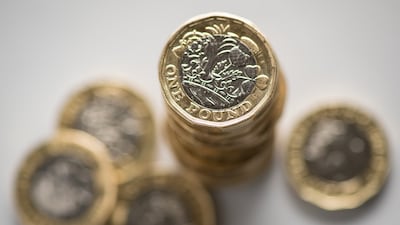The UK pound has been putting in a strong performance across August, as it touched a one-year high against the US dollar of $1.3054 on Tuesday.
At the same time, the British currency has been trading fairly steadily against the euro, with a euro worth around 85.37 pence.
“Currency markets are always a tricky one, both sides of every pair need to be looked at to try to understand moves,” Matt Britzman, senior equity analyst at Hargreaves Lansdown told The National.
As such, while currency trading is a stormy arena at the best of times, analysts say the weakness of the US dollar is providing a boost to both sterling and the euro at the moment, because of predictions the Federal Reserve will drop interest rates at a faster rate than had been previously forecast.
“The fact that (sterling) has moved against the US dollar this week is a function largely of the dollar weakness,” said Jane Foley, head of FX strategy at Rabobank.
Richard Hunter, head of markets at Interactive Investor agreed, adding that the pound is also benefiting from events in Britain as well.
“The ongoing resilience of the UK economy also offers some support, while the fact that the Bank of England has already moved to reduce rates reflects confidence in inflation largely having been tamed,” he told The National.
As such, the British pound has been the best-performing currency in the G10 group of nations so far this year, having risen about 2.3 per cent against the dollar.
Recent economic data has been relatively positive for the UK economy, with second-quarter growth increasing by 0.6 per cent, as last year's brief recession was well and truly placed in the rear-view mirror.
In addition, the new Labour government in the UK, which took over at the beginning of July, appears to have brought a sense of stability to the London markets for the time being.
Meanwhile, weaker-than-expected US non-farm payroll numbers released this month sparked a sell-off in global stocks and a corresponding rally in bonds as investors fretted that the US economy could be heading for a hard landing and a possible recession.
Interest rate divergence
All market eyes are now turning to the annual meeting of central bankers at Jackson Hole in Wyoming for further clues on the short-term future for US interest rates and corresponding movements in the dollar.

Bank of England governor Andrew Bailey is due to speak at Jackson Hole later on Thursday, with Fed chair Jerome Powell's speech scheduled for Friday.
“The future direction of currencies is extremely difficult to pin down, given the highly unpredictable macroeconomic trends which drive them,” Laith Khalaf, head of investment analysis at AJ Bell told The National.
“However, interest rate policy in each jurisdiction will likely have a big influence, especially if it starts to diverge.”
As such, divergence of interest rate policies is a key indicator of where the currencies will move relative to each other going forward.
The US Fed is expected to slash rates much more aggressively over the rest of 2024 than either the Bank of England or the European Central Bank (ECB), who've already started cutting rates in August and June.
Traders now see 94 basis points of Fed cuts across its three remaining meetings this year – that implies three 0.25 per cent reductions, with a strong chance that one of them will be larger. In June and July, that basis point prediction was around 30 points lower.
“It's a rate differential story,” said Commerzbank currency analyst Volkmar Baur.
“Inflation is coming down on both sides (of the Atlantic), but the Fed is expected to move a little bit more aggressively on the way down, and that closes the rate spreads a little bit and gives way for a stronger euro.”


